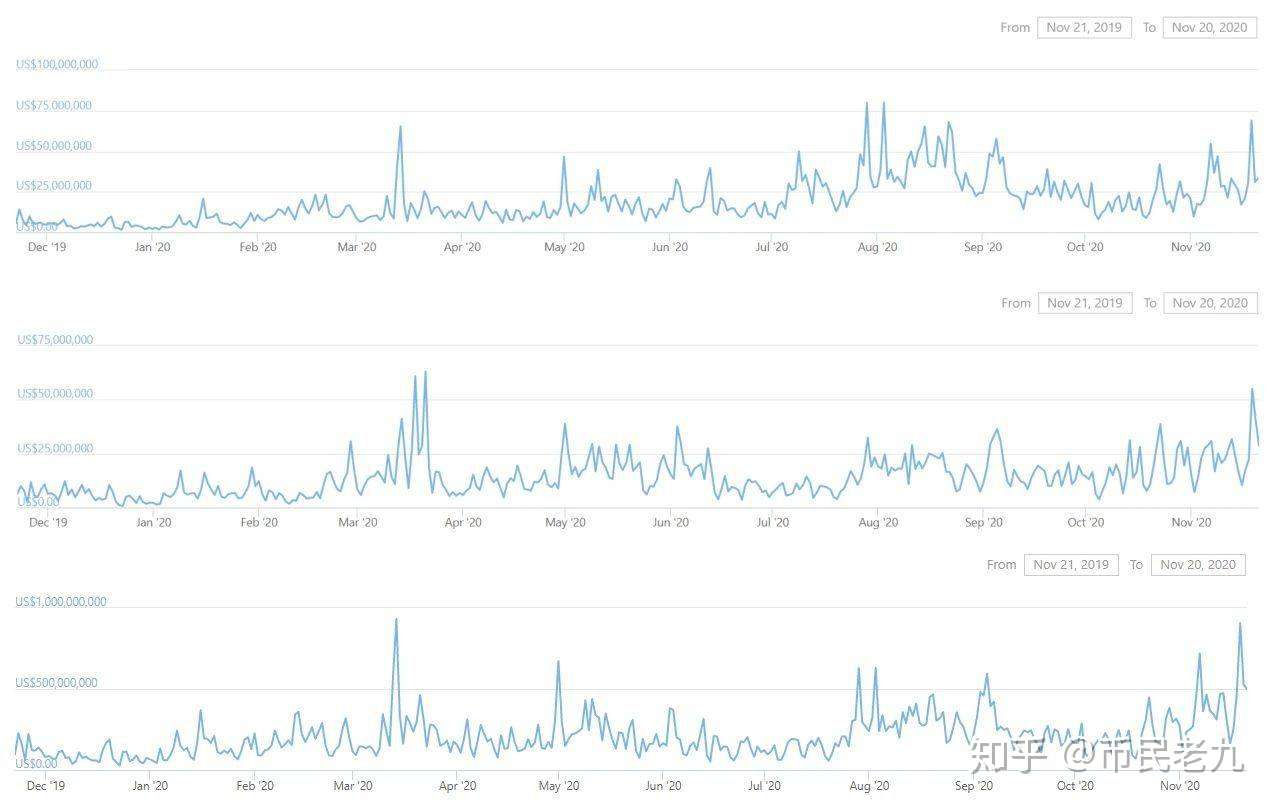三大所美国市场遇挫幕后:合规、创新与营收的冲突
币安、火币、OKEx作为国内背景的三大交易所,在全球加密货币市场交易领域占有龙头地位,但这并不能掩盖它们的一大尴尬,即始终无法在重要的美国市场取得突破,乃至频频受阻。
先是火币合作伙伴HBUS在运营一年多后宣布关闭,后是币安被《福布斯》曝出采取大量举措规避美国监管审查并可能遭到调查,尽管币安否认了这些指控,但仍然反映出该交易所并不友好的舆论环境。一名熟悉美国合规市场的行业人士陆屹(化名)告诉链捕手,三大所在美国主流加密市场看来都属于「高危」的企业。
再从交易量来看,截止11月18日12点,Binance US的24小时交易量为4228万美元,OKCoin的24小时交易量为3858万美元,相比之下美国本地合规交易所Coinbase与Kraken的24小时交易量都超过10亿美元,这个数据亦说明币安与OK在美国市场拓展一年多后仍然与当地交易所存在较大差距。

自上而下分别是Binance.us、OKCoin与Kraken近一年交易量走势,数据来自Coingecko
为什么三大所进入美国市场都会遭遇「水土不服」?美国交易所行业的主要难点在哪里?链捕手在经过大量采访与调查后认为,三大所探索美国市场的主要困境在于合规、创新与利润的三角冲突。
根据链捕手的了解,三大所对美国市场的开拓可以分为两条并行的路径,分别是直接在主站为美国客户提供服务以及成立当地合规交易所为美国客户服务。
一、第一条路径走不通
在三大所的早期阶段,它们的主站都可以接受美国客户的注册使用与交易,但随着美国监管层推出更加严厉的政策,三大所从18年初起也相继宣布停止为美国客户服务,转而以独立的合规交易所提供服务,例如HBUS、Binance.US、OKCoin国际站。
三大所之所以费尽周折地采取这种方式,很大程度在于美国严格的监管政策。「美国一直是全球加密资产监管中非常包容、非常严格同时也非常霸道的一个国家。」陆屹告诉链捕手。
早在15年6月,纽约金融服务部门(NYDFS)即正式推出了数字货币公司监管框架BitLicense,此后数十家公司获得该牌照。今年,美国货币监理署曾公开允许美国银行为客户托管比特币和以太坊等主流加密货币。今年9月,该机构办公室甚至允许银行合法地向稳定债券发行商(如Circle)提供服务。
「美国的加密货币监管政策非常清晰,只要在合法范围内做,不仅不会「堵」交易所,还会推出很多政策「疏」通市场,提供合法的法币出入金、结算方式,但问题在于加密资产合约交易、杠杠交易等产品在美国市场处于监管灰色地带。」陆屹说,「毕竟加密资产行业发展太快了,监管层很难跟上这么快的业务发展速度。」
对于三大所而言,它们过去几年陆续推出了基于加密资产的杠杠交易、合约交易、期权交易,以及IEO、平台币、杠杠代币等创新性的产品,探索为用户提供尽可能丰富的产品以及资产类型,以巩固自身的市场地位,但这些带有创新与探索性质的产品大多远超出美国监管层的允许范围,加之美国长期以来的长臂管辖法案,如果三大所通过主站为美国客户提供服务,那么一旦遭到美国监管部门的调查与指控,后果将相当严重。
BitMEX则是先例。今年10月初,BitMEX多名高管遭CFTC提起刑事诉讼,被指控在未注册时执行期货交易、提供非法期权、未能注册为期货委员会交易商、未能注册为指定合约市场、未能执行适当的 KYC 规则等罪名,同时其CTO Samuel Reed已经被逮捕。
此前,BitMEX并没有要求客户进行KYC程序,也就是说客户可以匿名地在该交易所进行合约交易以及无限制地提币,这为一定程度为犯罪人士洗钱提供了便利,其中就很可能会包括来自美国的客户。
因此,三大所长期以来也都在完善自身的相关KYC机制,例如币安创始人赵长鹏近日在接受彭博社采访时表示,尽管币安一直在封锁美国通道,但用户有时确实找到了绕开封锁的可行方法,币安会想出一个更聪明的方法来完善这个通道。
可以认为,三大所通过主站拓展美国市场的路径是完全行不通的,除非它们愿意停止合约、平台币等相关业务,否则在美国市场难逃监管部门的严厉打击。
二、探索合规之路
综前所述,第二条路径已经成为三大所的主要探索方面,推出独立的合规交易所来服务美国客户。在这方面,最早的尝试来自于火币。
18年1月,火币宣布任命蔡凯龙担任火币集团首席战略官兼美国代理总裁,全面负责火币集团在美国的业务拓展。2个月后,火币宣布获得美国MSB牌照并在当年7月初正式上线HBUS交易所。同时,火币邀请到前美图国际业务董事总经理、前金山软件美国公司总裁傅圣芳担任CEO。
不过在各种宣传口径中,火币强调HBUS和火币并不是子母公司或者隶属关系,两者之间仅仅是「独家战略合作伙伴」。「美国有所谓的长臂法案,交易所在美国经营和服务的时候需要进行隔离。」傅圣芳告诉链捕手,「火币也跟HBUS进行了彻底的隔离,火币并不是实质控制方,如果要藏也是藏不住的。」
在此后的一年时间,HBUS在美国50个州中的43个州获得了币币交易的经营许可证,部分州还允许进行法币交易。实现这个数据并不容易,美国大部分州对加密货币交易所设有不同的许可规则,申请流程相当繁杂,在获得MSB之外还需要单独申请各州的 MTL 或者信托牌照才能获得法币交易的业务许可。
19年3月,HBUS还组建了一个新的团队来推出其机构产品和服务,例如借贷与OTC交易。19年11月初,火币全球站发表公告称,将全面冻结全部美国用户的帐户,并促请用户尽速提领所有剩余资产。公告还表示,美国用户可以选择到火币独家战略合作伙伴HBUS开设帐户,并将资产转移至该平台。
但一个月后,HBUS即宣布停止提供交易服务,并计划「以更完整全面的方式回归」,这相当于火币之前在美国市场的大量资金与资源投入大半「打了水漂」,令市场倍感突然与意外。傅圣芳对此向链捕手表示:「美国市场的合规成本很高,股东作为投资人有自己的考虑,他们认为这不一定是最高效的方式。」
换言之,持续亏损或是HBUS选择停止运营的重要原因。「相对于申请牌照,其实后续的合规运营可能要耗费更多的精力与投入,需要非常谨小慎微地去遵守牌照制定的准则,假如有一名用户没经过KYC就进行交易都会引起诉讼,牌照也会出问题。」陆屹告诉链捕手。
HBUS为此长期保持巨大的投入,但这并不能换来美国市场用户的认可,HBUS的日交易量大部分时间都在百万美元上下,以0.2%的标准费率计算,这意味着HBUS的年度手续费收入大概是大几十万美元,在缺少上币费、合约手续费等其它收入的情况下,这很难覆盖其高昂的合规、团队与市场投入成本。尽管火币愿意为美国市场投入巨大资金,但在HBUS发展态势不顺、近乎成为「无底洞」的情况下,暂停交易服务的决定也就不难理解。
而在HBUS宣布停止交易服务的同时,币安在美国市场的合作交易所Binance US已经上线多月。19年6月,币安宣布将其撮合引擎与钱包技术授权于其美国合作伙伴BAM Trading ,以后者为运营主体的Binance US在9月中旬正式上线。
值得注意的是,尽管官方没有公布BAM Trading的真实身份,但仍有公开信息显示它与一家币安labs在18年8月投资的一家美国初创加密公司密切相关,这家公司至少3名重要团队成员曾在火币美国担任过重要职位,包括首席合规官等职位。
同时,币安还邀请到Ripple前高管Catherine Coley担任Binance US首席执行官,以上种种举措使得Binance US平台早期的发展颇为顺利,上线一个月后的日交易量即突破1000万美元。
不过在此后的1年时间,Binance US并没有大的突破,长期在2000万美元上下徘徊,直到近期随着比特币牛市才大幅上涨。
OKEx在美国市场的探索则是通过OKCoin进行的,该交易所于18年7月宣布获得美国MSB牌照并同时向美国客户提供服务,此后陆续开通了美国46个州币币交易业务以及42个州的法币交易业务。
据非小号数据显示,OKEx在18-19年大部分时间的日交易量都是数百万美元,直到今年下半年才开始稳定在2000-3000万美元。不过相比Binance US的交易量,OKCoin的交易量不仅包括美国市场,还包括新加坡、马耳他等众多国家的交易量,这意味着OKCoin在美国市场的实际交易量数据要更低。
三、三大所在美国的未来
无论如何,美国市场作为加密货币行业乃至整个金融市场的重心,为加密货币行业创造了相对良好的发展环境,公众对加密货币的认知也相对充分。本月初,美国货币监理署(OCC)代理署长Brian Brooks就在一份报告中表示,目前约有6000万美国公民持有某种加密货币,总市值接近4300亿美元,加密货币已成为一种用于发送和接收商品和服务付款的流行机制。
「美国市场仍然非常有前景。」傅圣芳表示,「虽然其中存在监管风险,但这个风险不同于国内的监管风险,美国监管风险是先说我告诉你这个业务不能做,那你做了我就会去调查和执法,国内则是说我没有这么细致的法律规定,你们可以先做,但是如果做得不合适我会来管你。」
因此,美国市场应当是火币、币安、OKEx三家交易所国际化布局不可或缺的一环,如今Coinbase、Kraken等交易所是美国市场的主导地位玩家,但三大所也并非没有机会。
「用过Coinbase的人都知道,它的用户体验其实没有国内交易所做得好,三大所的玩法也更加丰富,如果能让美国用户感受到他们的便利性与本地化还是有机会的,这个市场永远都是阶段性的赢家和阶段性的输家,主要看谁能更加贴近用户。」陆屹说。
在费率方面,Binance US、OKCoin的交易手续费也具有存在优势,Coinbase、Kraken两家交易所的官网显示最高费率甚至达到0.5%与0.26%。
「三家交易所需要拥抱西方的文化和思维,甚至拥抱西方的做事方式,要有懂当地政治环境和法律的专业人士,这样会走得更快。」陆屹进一步表示。
币安与OK在这方面正在做出努力,火币也没有完全放弃美国市场。今年4月,火币集团全球业务副总裁Ciara Sun曾对媒体表示,火币计划与当地合规平台合作重启交易业务,这将使其能够以较低成本的方式合规运营,最早可能在当月重回美国市场。
「火币一直在与一家加密经纪公司洽谈潜在战略合作,内容可能涉及收购对方少数股权。」Ciara Sun说,「通过与一个完全受监管的当地合作伙伴合作,我们不必向各州申请交易牌照。我们将以火币集团身份重返美国市场,不再是火币美国(HBUS)这样的独立实体。」
但直到7个月后的当下,Ciara Sun所提到的重启仍然没有任何公开迹象,这或许说明其合作进展并不顺利,重返美国的时间仍将继续推迟,但从前面的表述来看,火币计划以不同于币安与OK、借助当地成熟合规平台的路径重返美国市场,这或许也将有机会取得新的突破。
在合规、创新与营收的三大因素的冲突下,火币、币安与OKEx三大交易所在美国市场经历了跌宕起伏的几年时间,而随着市场规模的扩大以及三大所未来采取更加有效的打法,其中或许将有某一家交易所能突出重围,值得市场的长期关注。










